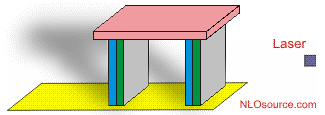
Most of today's high-tech marvels are based on the tiny transistor, a device that controls the flow of electrical current. A transistor mediates the flow of one current depending on the properties of a second current. Since the interaction is nonlinear, a transistor can be used to amplify a weak signal, perform logic operations, and be used as a memory element. While a single transistor may be technologically unimpressive with regards to computing power, millions of them working together can perform amazing functionality that some day may meet the criteria of intelligence.
I envision a technology made of Photomechanical Optical Devices (PODs), each with the ability to control the flow of light based on the environment (stress, temperature, chemical agents, etc.), having multiple states for a given set of input parameters (i.e. optical and mechanical multi-stability), and having the ability to change shape based on the inputs. Integrating such devices together would lead to ultra-intelligent morphing materials/systems that would enable technologies that are yet to be invented. I have been dabbling with research in this area for 20 years.
The time is ripe to build the scientific foundations for making a novel new material/system that has the ability to morph in response to stress or light. In contrast to common materials that are made of atoms or molecules, and interact through electric fields, I envision a system made of microscopic units that each communicate with all others using light, imbuing it with enormous processing power and intelligence. Add to each unit the ability to respond to stress and perform actuation, and the system gains the ability to intelligently morph between complex structures. Miniaturization of such systems blurs the line between what is conventionally meant by a system and a material - terms that I use interchangeably.
Such materials would fill a new realm of applications. A series of pictures on a piece of film are projected onto a two-dimensional screen to show motion. A smart material, on the other hand, could be made to morph through a series of shapes leading to true 3-dimensional solid-body animations. For example, automobile designers could use them to continually change the shape of a model to test its aerodynamics or aesthetics; a chair could be made to automatically change shape to accommodate a particular body type; and an exact replica of an individual could be made in real time from information sent from a remote location, in effect recreating an animated three-dimensional solid replica of the sender. And you thought picture phones were great! Other applications would include noise cancellation wallpaper, reconfigurable air craft wings, ultra-stable platforms for precision manufacturing or characterization, and reconfigurable optical filters.
The development of such materials/systems would require extensive research aimed at demonstrating the fundamental building blocks, followed by studies of how a small number of them interact with each other when interconnected with light, and would culminate with the development of fabrication methods that could be used to make a bulk material from a collection of microscopic building blocks. Some aspects of the fundamental physics underlying this idea are in place; that is, photomechanical materials exist, interferometers with such materials can be built into polymer fibers, and a series of gratings can be written into a fiber, which in principle, could be made into a network of interacting units. The challenge lies in demonstrating classes of fundamental units that are naturally integratable, and understanding how to build a system from optimized units that work together to provide the desired function.
My vision of the fundamental building block is a waveguide-based feedback device, such as an interferometer, that is made in thin films or fibers, containing a nonlinear-optical and photomechanical material -- thus simultaneously having the ability to manipulate light, sense stress, and apply anisotropic stress to its surroundings. These PODs would simultaneously respond to optical and mechanical stimulus to yield mechanical/optical multistability, logic, stress/temperature sensing, optical/mechanical memory, positioning, and more. A network of PODs, interconnected by light signals along an integrated waveguide device would be scalable to a an ultra-smart material/system with functionality that goes well beyond present materials/systems paradigms. In contrast to a neural network, in which each neuron is connected to a small number of neighbors, a linear array of PODS along an optical fiber would interact with all others, processing information, reacting to stress and responding by selectively passing light and stressing the surroundings.
The development of this new technology may impact many future applications that have not yet been invented. Conversely, the novel materials concept may motivate new ideas for applications that have yet to be invented. I have submitted this idea to the National Science Foundation as part of a solicitation that seeks suggestions for new programs in areas that have the potential for transforming socienty. If NSF chooses not start a major program in ultra-smart morphing materials, I am hoping that this kind of research will someday be supported - even if I am not around to participate.
No comments:
Post a Comment